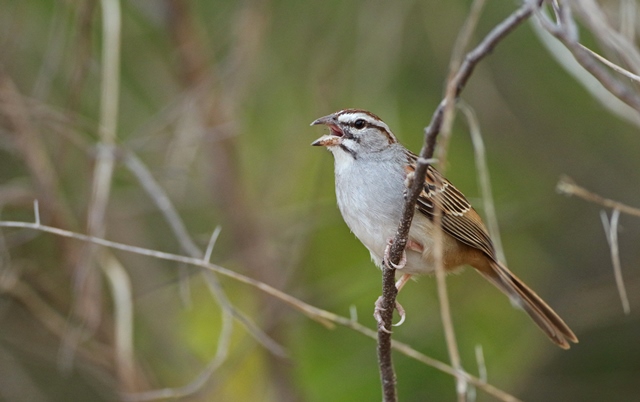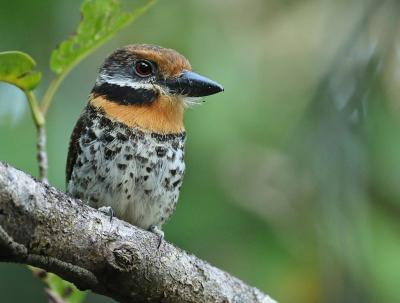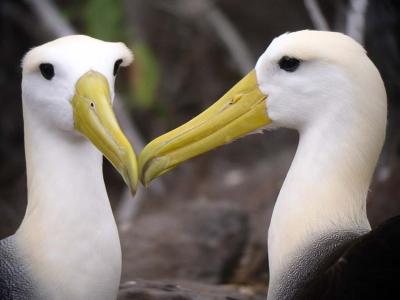Mexico: Oaxaca and Western Chiapas
-
Mar 10-21, 2026
Steve Howell and Rich Hoyer
Tour Price to be Determined
Tour Price to be Determined
This exciting tour focuses on one of the richest areas of bird endemism in Mexico: the Isthmus of Tehuantepec. Beyond the endemics, the region’s unique blend of species reflects its location at the point where the Nearctic faunal realm meets the Neotropics. South of the isthmus, for example, there are no more chickadees or nuthatches, two bird families very much part of the temperate northern avifauna, but diversity shoots up in terms of antbirds and tyrant flycatchers, two families centered in the Neotropics.
We’ll start in Tuxtla Gutiérrez, a modern city and the state capital of Chiapas, which lies within driving distance of habitats ranging from arid scrub to rain forest and humid pine-oak highlands. We’ll head next to Arriaga, on the Pacific side of the isthmus, and then move west and north to end in Oaxaca City, a time-honored favorite of birders and travelers. Within a short distance of Oaxaca City, we’ll explore habitats ranging from cool montane forest to arid scrub, and we’ll experience some of the cultural diversity for which Oaxaca is famous. Birds along the route run the gamut from the elusive Lesser Ground-Cuckoo and Giant Wren (as big as a Dwarf Jay!) to the electrically colored Rosita’s Bunting and the little-known Nava’s Wren.
Day 1: The trip begins at 6 p.m. this evening in the lobby of our Tuxtla Gutiérrez hotel. Night in Tuxtla Gutiérrez.
This is a superbly conceived and executed tour with an itinerary that provides an outstanding introduction to the birds and biogeography of this region. The pace was brisk, but the leaders succeeded in making sure that as many clients as possible saw (and heard) most of the key endemic and cryptic taxa that we encountered. This was achieved without the schedule becoming tiring or burdensome. - Nick W.
Days 2-4: Just north of Tuxtla is the dramatic Sumidero Canyon National Park, where the Grijalva River cuts its exit from the central valley of Chiapas to drain eventually into the Gulf of Mexico. We’ll devote most of two days to this superb area, whose birds include Lesser Roadrunner, a variety of hummingbirds, Ash-throated, Nutting’s, Brown-crested, and Belted Flycatchers, Blue-and-white Mockingbird, Red-breasted Chat, Yellow Grosbeak, the rare bamboo specialist Blue Seedeater, and the poorly known Bar-winged Oriole. We’ll also explore other areas in the vicinity of Tuxtla, among them Atlantic slope rainforests, where we may find the very local and increasingly difficult Nava’s Wren, and highland pine-oak forests, home to birds like Unicolored Jay, Golden-browed Warbler, and Garnet-throated Hummingbird. We might even try to find the handsome Pink-headed Warbler, if we’re very lucky. We’ll also visit the world-famous Tuxtla Gutiérrez zoo, where many of the birds and mammals roam freely in native forest: Great Curassows wander the trails and spider monkeys swing overhead. Nights in Tuxtla Gutiérrez.
Day 5: This morning we’ll head inland to Arriaga, on the Pacific slope of the Isthmus, starting in some Atlantic Slope rainforest before winding down through foothills that are home to one of Mexico’s most localized endemics: Rosita’s Bunting, named in honor of the wife of François Sumichrast. Having seen this bird, one may conclude that if Rosita was as beautiful as her namesake, then Sumichrast was indeed a lucky man! Other birds in the area include Canivet’s Emerald, Orange-breasted Bunting, and Stripe-headed Sparrow. Night in Arriaga.
Day 6: Today we’ll explore the nearby coastal lowlands, where birds include a good variety of wintering migrants as well as a suite of resident species such as the amazing Giant Wren, bounding flocks of Orange-chinned Parakeets, and handsome Spot-breasted Orioles. Numbers of waterbirds vary from year to year, but we expect to see a good variety of herons, Magnificent Frigatebirds, and a few shorebirds and terns. Night in Arriaga.
Day 7: This morning we’ll bird near Arriaga or Puerto Arista again, depending on what species we’ve already seen, before heading to Tehuantepec after lunch. In late afternoon we’ll look for Sumichrast’s (or Cinnamon-tailed) Sparrow, a very local endemic named in honor of the pioneering French naturalist who resided on the isthmus for many years in the late 1800s. Other birds in this area include the secretive Lesser Ground-Cuckoo and the spectacular White-throated Magpie-Jay. We may also try some owling at dusk. Night in Tehuantepec.
Day 8: Today is a travel day as we make the spectacular drive through diverse cactus desert from the heat of Tehuantepec up to the temperate Oaxaca Valley. Birds change accordingly, from Ferruginous Pygmy-Owl and Rufous-naped Wren to Gray-breasted Woodpecker and White-throated Towhee. Often this is a good drive for hummingbirds, and we’ll look especially for the endemic Turquoise-crowned (Doubleday’s) Hummingbird. Night in Oaxaca.
Days 9-11: We’ll spend three days visiting habitats within an easy drive of our hotel, building an idea of the avifauna in a diversity of habitats at the southern end of the Nearctic region and finding a variety of little-known endemics. Birds around Oaxaca include Beautiful Hummingbird, Pileated Flycatcher, Mexican Chickadee, Dwarf Jay, Brown-backed Solitaire, Slaty and Dwarf Vireos, Red Warbler, and, of course, the very local Oaxaca Sparrow. Nights in Oaxaca City.
Day 12: The trip concludes this morning in Oaxaca City.
Note: The information presented below has been extracted from our formal General Information for this tour. It covers topics we feel potential registrants may wish to consider before booking space. The complete General Information for this tour will be sent to all tour registrants and of course supplemental information, if needed, is available from the WINGS office.
ENTERING MEXICO: U.S. citizens traveling to and from Mexico must have a passport, valid for at least six months after the date the tour ends, or another secure, accepted document to re-enter the United States. Citizens of other countries may need a visa and should check their nearest Mexican embassy.
COUNTRY INFORMATION: You can review the U.S. Department of State Country Specific Travel Information here: https://travel.state.gov/content/travel.html and the CIA World Factbook here: https://www.cia.gov/the-world-factbook/. Review foreign travel advice from the UK government here: https://www.gov.uk/foreign-travel-advice and travel advice and advisories from the Government of Canada here: https://travel.gc.ca/travelling/advisories.
PACE OF THE TOUR: We will try to be in the field at dawn or shortly afterward. Most birding sites are about 30 to 60 minutes from the hotels; the longest day is our drive from Tehuantepec to Oaxaca City, which takes most of the day (with birding stops and lunch en route). Most or all breakfasts will be picnic-style in the hotel parking lot or in the field, usually between 5:00 and 6:00am. Some lunches will be picnic and some will be in restaurants. All dinners, except perhaps one when we go owling in the mountains near Oaxaca City, will be in restaurants. On several days we plan an afternoon break (siesta) after lunch, when it will be too hot for enjoyable or productive birding.
Birding in and around the Valley of Oaxaca is at 5,000 feet elevation and, other than uneven ground and a few narrow, scrubby trails, the walking presents no particular problem. We will also venture up to over 9,000 feet in the mountains of Chiapas and Oaxaca, where we will be birding on dirt roads and not in any rush. Near Tehuantepec and Arriaga we may be on narrow trails in thorn forest and at El Sumidero we will be birding mostly from a paved road.
We spend a good amount of time on our feet, although most distances are relatively short. We may walk up to 2 miles at a time, but at a slow birding pace with plenty of stopping and standing. Most of the terrain is relatively flat, with a couple exceptions: we will likely walk up several stretches of steeper roads near San Cristobal and Oaxaca. Some participants might find a folding stool useful to take a quick break while we’re birding.
HEALTH: The Centers for Disease Control and Prevention (CDC) recommends that all travelers be up to date on routine vaccinations. These include measles-mumps-rubella (MMR) vaccine, diphtheria-tetanus-pertussis vaccine, varicella (chickenpox) vaccine, polio vaccine, and your yearly flu shot.
They further recommend that most travelers have protection against Hepatitis A and Typhoid. Please contact your doctor well in advance of your tour’s departure as some medications must be initiated weeks before the period of possible exposure.
The most current information about travelers’ health recommendations can be found on the CDC’s Travel Health website here: https://wwwnc.cdc.gov/travel/destinations/list
Malaria: It is the opinion of the Centers for Disease Control that travelers to the Mexican states of Oaxaca and Chiapas are at low risk for malaria. You should consult further with your doctor about the CDC’s recommendation and what action you should take.
Altitude: We reach maximum elevations of about 9,000 feet in the mountains of Chiapas and Oaxaca. The Valley of Oaxaca is everywhere about 5,000 feet.
Smoking: Smoking is prohibited in the vehicles or when the group is gathered for meals, checklists, etc. If you are sharing a room with a nonsmoker, please do not smoke in the room. If you smoke in the field, do so well away and downwind from the group. If any location where the group is gathered has a stricter policy than the WINGS policy, that stricter policy will prevail.
Miscellaneous: Insects and arachnids are seldom a major nuisance although chiggers and biting gnats can be locally numerous.
We have found that with careful eating habits, intestinal problems can be largely avoided. In most of Mexico, it is unwise to drink untreated water. Bottled water and soft drinks are reliable and widely available.
CLIMATE: Overall the weather should be warm (70s to 80s F) and dry (inland) to humid (near the coast), although possibly cool (40s F) in the early mornings, especially around Oaxaca City. For our one morning near San Cristobal, it can be very cold to start (sometimes near freezing!), but usually warming up to comfortable temperatures by mid-morning. If you’re sensitive to cold, it is worth packing a hat and gloves for this morning. The high temperatures near Puerto Arista and Arriaga could reach close to 100 F during the middle of the day. We rarely encounter rain except at El Ocote (which is rain forest), but light rain or mist is possible in some areas, especially at Cerro San Felipe.
ACCOMMODATIONS: We stay in comfortable hotels throughout the tour, with private bathroom facilities and restaurants. Wi-fi is available at all hotels but is often intermittent and, when it does work, not very fast, so it shouldn’t be relied upon for important communications.
FOOD: Food is of good quality with standard “Mexican” fare.
Food Allergies / Requirements: We cannot guarantee that all food allergies can be accommodated at every destination. Participants with significant food allergies or special dietary requirements should bring appropriate foods with them for those times when their needs cannot be met. Announced meal times are always approximate depending on how the day unfolds. Participants who need to eat according to a fixed schedule should bring supplemental food. Please contact the WINGS office if you have any questions.
TRANSPORTATION: Transportation is by 12-passenger or 15-passenger vans. Those who suffer from motion sickness should bring their preferred medication, as some drives involve distinctly winding roads. Tour participants should be able to ride in any seat in our tour vehicle(s).
2024 Narrative
In Brief: Our tour of Oaxaca and western Chiapas is designed to sample a variety of habitats across the isthmus and search for many of the specialty birds of the region. Beginning in Tuxtla Gutierrez, our birding ranged from the bamboo-choked woodland at Sumidero Canyon to the high-elevation pine-oak forests of San Cristobal to the humid rainforest at El Ocote, with birds like Red-breasted Chat, Pink-headed Warbler, and Keel-billed Toucan keeping us duly entertained. From Tuxtla, we descended to the Pacific slope, through gorgeous Rosita’s Buntings (and bonus Great Swallow-tailed Swifts!) to conspicuous Giant Wrens and Spot-breasted Orioles. Heading across the isthmus of Tehuantepec, habitats and birdlife changed dramatically. We appreciated amazing views of most of the Oaxaca specialties, including prolonged eye-level Dwarf Jay, confiding Oaxaca Sparrow, Ocellated Thrasher, skulking Slaty Vireo, Boucard’s Wrens and Bridled Sparrows…plus great food and no major logistical hiccups! It’s easy to see why this tour deserves its popularity. I’m excited for next time!
In Detail:
Day 1: Almost everyone arrived with time to settle in, do a little independent local birding around the hotel, and perhaps even jump in the pool to cool off before our intro meeting and first night dinner.
Day 2: Our early start to Sumidero Canyon really paid off, with great views of a flashy male Red-breasted Chat, along with a male Varied Bunting and an introductory foray into the world of Myiarchus flycatchers. Clear sunny skies meant that bird activity waned fairly early but we still enjoyed a good variety of birds, such as a glowing male Yellow Grosbeak, noisy Black-headed Saltators, a selection of taxonomically vexed vireos, plus scope views of some decidedly cryptic Singing Quail. ‘Non-feeder’ hummingbirds were also fun, of sometimes challenging, including a showy Plain-capped Starthroat, dazzling male Canivet’s Emerald, and handsome Azure-crowned Hummingbird (with azure crown seen, even if looked more like violet!) and Buff-bellied Hummingbird. After a fine picnic lunch and spectacular views of the canyon we headed back for a welcome siesta before an afternoon foray to the famous Tuxtla zoo. Here, normally shy birds like Great Curassow are easily seen strutting around, and we enjoyed a particularly good show from multiple Russet-crowned Motmots. In all, an excellent introductory day to birding in this part of the world.
Day 3: Wow, what an exceptional day around San Cristobal! We arrived at a reserve on the outskirts of town to the predicted cold (frost on the ground!) and quickly started racking up some pine-oak species. Right off the bat, we were shocked when our local guide Alberto showed us a roosting Bearded Screech-Owl…a total bonus! Climbing higher uphill, we enjoyed mixed warbler flocks as the sun hit the hillsides, with Crescent-chested, Hermit, Townsend’s, Red-faced, Golden-cheeked (!), and eventually the much-desired Pink-headed Warbler! Supporting cast included Rufous-collared Thrush, Garnet-throated Hummingbirds (delightfully common this year), Strong-billed Woodcreeper (the Central American one, sounding very different from Sclater’s which we saw later in Oaxaca), Unicolored Jay, Black-capped Swallow, and even a Guatemalan Pygmy-Owl. After a great lunch in town, we continued to a different spot, rounding out our excellent haul of highland species with a very cooperative Blue-throated Motmot.
Day 4: Another morning at Sumidero Canyon, this time starting a little higher up and working our way to the farthest overlook. We focused on Belted Flycatcher, which seems to be getting more difficult to find, and most of the group eventually connected with brief obstructed views. Much more obliging was a Flammulated Flycatcher that seemed desperate to be seen, plus plenty of other bits and pieces…a young male Red-breasted Chat was much appreciated, and we sorted through mixed flocks with Blue-headed and Gray-headed (Central American “Plumbeous”) Vireos, and Black-throated Green, Black-and-white, and Magnolia Warblers. And in the big-colorful-birds department, we had great views of Gartered Trogon and Lesson’s Motmot! After a picnic lunch followed by a siesta at the hotel, we headed out to El Ocote in the afternoon, with Nava’s Wren on our minds. Unfortunately, with increased pressure from birders and playback, this species seems to be getting harder and harder to see. We certainly heard it (loud and close!) but never caught a glimpse. It is a spectacular song!
Day 5: We departed from Tuxtla the next morning and headed to our next base, Arriaga, via some morning birding again at El Ocote. Conditions were difficult with dense fog, but we practiced birding-by-ear as we walked down the road, with a “heard of wrens” keeping us busy (Spot-breasted, White-bellied, Cabanis’s, House, and White-breasted Wood-Wrens all heard). A perched Long-billed Starthroat was quite nice, and we pieced together plenty of other nice birds including Collared Trogon, White-crowned Parrot, Masked and Black-crowned Tityra, and Keel-billed Toucan.
We made it to Arriaga for lunch and a siesta, followed by some birding up in the foothills. We were pleasantly surprised with Great Swallow-tailed Swift at the overlook, plus a ton of migrating Western Kingbirds, Scissor-tailed Flycatchers, and even Red-legged Honeycreeper seemingly traveling with the Western Tanager flocks. Further downslope we enjoyed great views of Green-fronted Hummingbird and White-lored Gnatcatcher before finally connecting with the sought-after Rosita’s Bunting, one of the best birds of the tour! Initial quick glimpses were upstaged when a male decided to perch only a few meters away and quietly sing his head off. Absolutely stunning!
Day 6-7: The next two days saw us birding in the coastal lowlands around Puerto Arista and El Paredon, which held a whole new suite of birds. Our list was padded with lots of waterbirds: Magnificent Frigatebirds circled overhead, Wood Storks and White Ibis flew by, Green and Ringed Kingfishers hunted over the river, and Reddish Egrets fed in the shallows. The main target in this area, however, is the impressive Giant Wren, which proved quite easy and cooperative! There were almost too many birds to look at in addition to the wrens, with migrating Western Kingbirds, Scissor-tailed Flycatchers, and Orchard Orioles overhead, Spot-breasted and Altamira Orioles in the flowering trees, Common Black-Hawks putting on a show, Yellow-naped Parrot perched up nicely, funky Yellow-winged (Mexican) Caciques, and the local White-bellied Chachalaca. We even connected with the should-be-split Salvadoran (or Ridgway’s) Flycatcher, which sounds completely different from the other Nutting’s. Another brief foray into the foothills in the afternoon gave us even more Great Swallow-tailed Swifts (vocalizing and courting!) plus eye-level Grace’s and Yellow-throated Warblers.
A long afternoon drive brought us to Tehuantepec, where we enjoyed an evening of owling in the dry thorn scrub. A quick stop at the river in town was productive for waterbirds (Blue-winged Teal, Northern Shoveler, Redhead, and Lesser Scaup padded our duck list, plus lots of American Coot, Common Gallinule, Least Grebe, and a couple Osprey, among other things!) Upon arrival, it was a relief to see Cinnamon-tailed (Sumichrast’s) Sparrow extremely well in the evening to save us some pressure the next morning. An evening highlight was a Collared Forest-Falcon that nearly took our heads off, and Mottled Owl posed nicely if briefly after dark.
Day 8: Today was mostly a travel day, making the long drive from the isthmus to the Oaxaca Valley. Some early morning birding on the Guiengola Road produced the recently-split (officially) Turquoise-crowned (Doubleday’s) Hummingbird and finally a stunning male Orange-breasted Bunting! On into the hills, we made another stop which was good for several Plain-capped Starthroats, more Turquoise-crowned Hummingbirds and Orange-breasted Buntings, Ash-throated and Nutting’s Flycatcher, and even a Lesser Ground-Cuckoo that ran across the track! Finally into the real Oaxaca Valley, where lunch at Rancho Zapata gave us our first taste of the new suite of birds: Boucard’s Wrens bouncing around while we ate lunch, Gray-breasted Woodpeckers noisily flying around the cactus, Curve-billed Thrashers running around the gardens. We made it to our hotel with some time to rest and gear up for the next three days of birding.
Day 9: The road up Cerro San Felipe was our first port of call, starting in the oak scrub and ending in cool pine forests at over 9,000 feet. As the sun hit the lower slopes, the birds came fast and furious…a whole tree full of Gray Silkies with a pair of Elegant Euphonias! Roadside Oaxaca Sparrows scratching with White-throated Towhees! Black-vented Orioles in the flowering tree! Blue Mockingbird singing in the open! Wow…there were new birds everywhere. We made it off the main highway and even connected with a singing Ocellated Thrasher and a skulking Slaty Vireo nearby. From here we moved higher into the cool pine forest, where we stopped the van precisely where a flock of Gray-barred Wrens and…Dwarf Jays were calling! Amazingly, the jays foraged at eye-level for at least fifteen minutes and even bathed briefly in a stream below us, giving us incredible views at this increasingly difficult species. Of course, our first Red Warblers were duly savored, followed by more great highland birding…warbler flocks, Sclater’s (Strong-billed) Woodcreeper, Collared Towhee and Rufous-capped Brushfinch and Blue-throated Mountain-gem at our lunch spot, and very confiding Red Crossbills and Mountain Trogon in the afternoon.
Day 10: This morning was spent at lower elevations, starting at Yagul with Cassin’s Kingbird, Loggerhead Shrike, Blue Grosbeak, more Boucard’s Wrens, Curve-billed Thrashers, and several good views of quite a few Beautiful Hummingbirds! It took a while but we eventually tracked down the stunning Bridled Sparrow (perhaps my favorite sparrow in Mexico) which sat up nicely on some cactus below eye-level. We then explored a nearby reservoir with surprise West Mexican Chachalacas sitting still in the roadside thickets, our first Black Phoebe, and a nice bunch of migrants including Hermit Warbler and a flock of Chipping Sparrows. After a drive-by of the Tule tree (the stoutest tree in the world!) and a nice lunch at Palapa de Raul, we ventured up yet again into the pine forests for a picnic dinner and some owling. Conditions were pretty good and we started out with several Mexican Whip-poor-wills singing as dusk fell, but the main highlight was certainly the Fulvous Owl that came in (after significant effort). Great, repeated views were enjoyed by all.
Day 11: Our final day was spent north of Oaxaca city, starting on a quiet road through oak scrub and continuing to another long road up into the pines and oaks. At first, things were incredibly quiet…the quickest of glimpses of Dwarf Vireo were hardly satisfying, but it was quite nice to connect with Red-headed Tanager on our way back to the van! We then worked our way upslope, where the blazing sun didn’t help, but we managed to pull in some nice mixed flocks of warblers and various other passerines (Crescent-chested, Hermit, Townsend’s, Red, and Red-faced Warblers, Hutton’s and Plumbeous Vireos, Ruby-crowned Kinglets, Hammond’s Flycatcher). A clear highlight was the wonderful Lesser Roadrunner that Nick spotted hunting at the edge of a dry pond. We savored this for a while before heading into the shady pines for a picnic lunch, and for a grand finale, connected with a stunning Chestnut-sided Shrike-Vireo…certainly one of the best vireos in the world, and this one sat still for fifteen minutes while we watched in the scope! An awesome way to wrap up the tour!
All too soon, it was time to head back to the hotel for a final delicious dinner (mmm, mole). Thank you, everyone, for such a wonderful tour full of great birds, food, scenery, and camaraderie! Until next time…
- Luke Seitz
I've had the good fortune of birding with a few of this hemisphere's best birders, now I've done so with another. I can't think of a single criticism with respect to the leadership provided by Luke Seitz. He worked hard, seemed to know every sound, found and scoped birds quickly, and was a knowledgeable, pleasant and witty companion. I hope I have the opportunity to accompany him again.
- Nic K. on Mexico: Oaxaca and Western Chiapas
This is a superbly conceived and executed tour with an itinerary that provides an outstanding introduction to the birds and biogeography of this region. The pace was brisk, but the leaders succeeded in making sure that as many clients as possible saw (and heard) most of the key endemic and cryptic taxa that we encountered. This was achieved without the schedule becoming tiring or burdensome.
- Nick W. on Mexico: Oaxaca and Western Chiapas
Maximum group size seven participants with one leader; 10 participants with two leaders.


























































